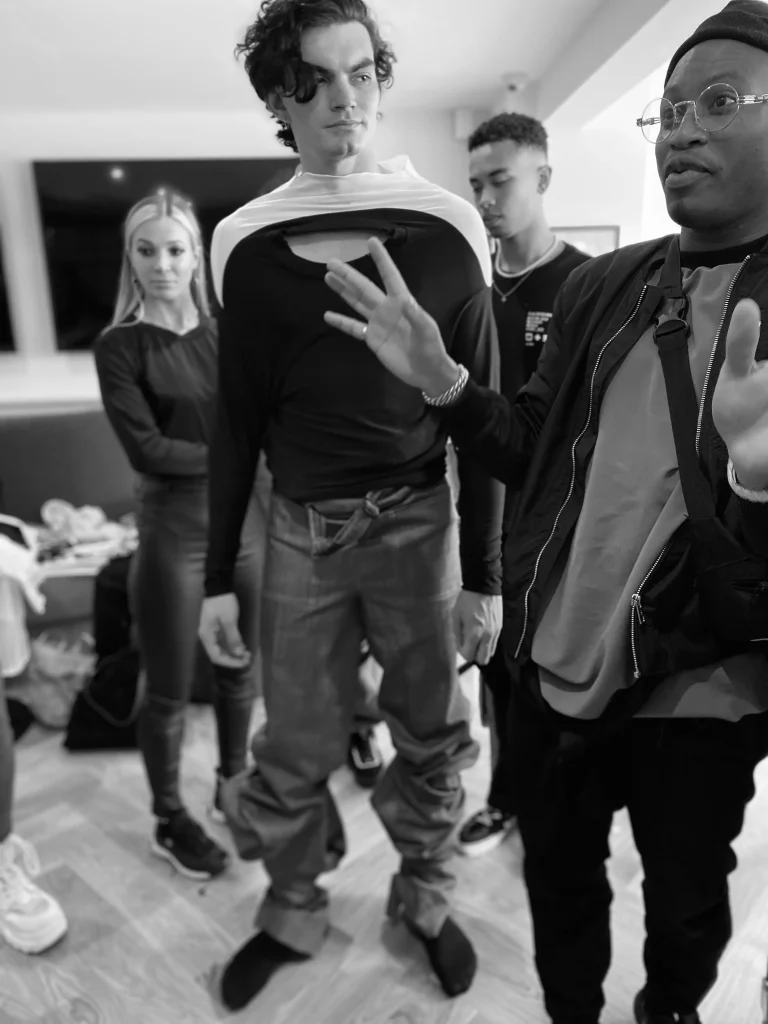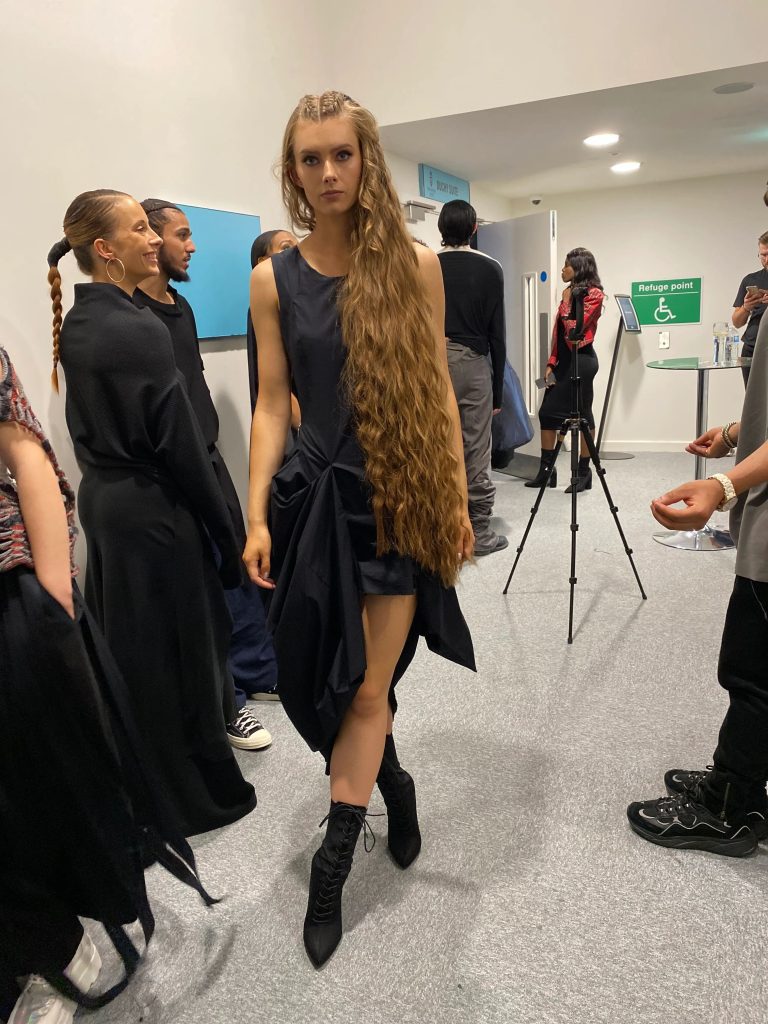The enthusiasm with which Shola, the designer behind someoneson, talks of his craft is infectious – nay, contagious. Fashion clearly fascinates him – he talks in animated tones of warped realities, the disruption of gender normatives by Harry Styles and deconstructing minimalism. But let’s not get ahead of ourselves.
We are at the Oval Cricket Ground in South London where his collection has opened the second half of proceedings for Fashion Show Live during London Fashion Week SS22.
Does he think his show was well received? “I hope so,” he begins tentatively. “I mean there was some clapping but until the press gives their verdict I don’t really know because art is subjective and people take away different things . .”

He tells me he sources his own fabrics and makes every piece himself. That’s pretty good going but then Shola is not a man who takes shortcuts. His first degree was in sociology and anthropology. Then 2 years of an extended Fashion Diploma. Followed by another 3 years studying Fashion Design Technology at the London College of Fashion. “It was very expensive but I’m very glad that I did invest the time into ‘official fashion training’. It made me start to ground every single idea I have in reality or at least in art terms.”
Nevertheless the influence of the sociologist’s lens is a recurring theme throughout our conversation. “. . . I view clothes completely differently. You see a dress shirt. I see masculine influences. You see a pair of pants. I see something that has been used to divide gender. You see a skirt. I see something that’s primarily ascribed to feminine roles and it’s those nuances that I try to bring across in my collection. . . .realities are different and because of the way my brain is wired I don’t see the world in straight lines. It’s more warped for me.”
His approach is certainly multi-layered but essentially the crux and genesis of his design practice is mental health. The clue is in the title of his collection: . “ As a person who lives with anxiety and depression sometimes I can’t tell whether I’m depressed or sad. It sounds like a bizarre thing to say. But that was where the collection started for me.”
This is not an admission I saw coming. Backstage I worked with him on fittings, where his manner was noticeably easygoing and relaxed. He even managed the odd joke which had the effect of creating a warm safe atmosphere around him which is no mean feat, hours before a live show when nerves are generally fraying. He touches on this dichotomous contradiction;
“On some days I wake up and I feel invincible. And some days I feel essentially vulnerable. And when you walk through the world in such polar opposites of emotional capacity it’s easy for you to worry about how people perceive you because on some days you are this chatty, this social person and on another day you wake up and then you are so low that you don’t want to talk to people . . .”
“Whether or not people live with anxiety personally everyone understands what being depressed is now that everyone’s experienced lockdown. . .the underlying lethargy, that feeling of not wanting to face the world.”
Besides his own personal journey with mental health, and the anthropological leanings Shola also draws from his experience and observations of Nigerian culture. He waxes lyrical about Nigerian headwraps, both fascinated and inspired by the consistency and versatility of this piece which he boils down to “ a rectangular piece of cloth that is basically warped to create these elaborate styles.”
His pieces share a simplicity underlined with a layer of subversion. There are no prints or patterns and colour does not feature heavily. One of my favourite pieces (and Shola’s too) is a simple but elegant and interesting sleeveless dress with a draped and gathered asymmetrical skirt.
“Everything I do is filtered through the lens of deconstruction and minimalism. I call it ‘deconstructed minimalism’. Deconstruction has so many varied aspects to it and because essentially I like to try to simplify things to the base which is my idea of deconstructing things. But you can also reconstruct it and make it maximalism and make it like really huge. I like things that are really simple but the origins of it are still there.”
“So I decided to go through the lens of minimalism to approach deconstruction. So when I take things apart I look for a common denominator and then I work with that. And in a way its subverting what people think. My reality is warped. I looked at deconstructing trousers and turning them into skirts . A sleeve becomes something to wear around your waist. A neckline becomes a sleeve detail.”

For Shola the heady mix of social sciences , art and mental health have converged with unapologetic intent. But then it’s hardly surprising that someone who has studied social interaction and behaviours would view his craft as a route for shifting social dynamics.
“One of the ways people actually listen and pay attention is through clothes. It makes a first impression and a lot of times that first impression makes you ask questions. And that question, when it’s exciting, leads to understanding. I like a good honest conversation about mental health because I think the more you talk to people and actually try and listen to them, because we don’t listen anymore – everyone’s just talking, but when you talk to people and actually listen to them the more you understand that we’ve got more things that actually connect us than tears us apart. So, with this collection I wanted to reflect that . . .”
We sign off with what could be a timely mandate for aspiring designers in these increasingly fractious times:
“ . . .if we create clothes that are exciting and create depth and there’s nuance in it, isn’t that just another way of creating human connections? It sounds like I’m on this grandiose mission to save the world – which I am not”, he laughs.
Still, I can’t help but think and hope he could be onto something. . .
